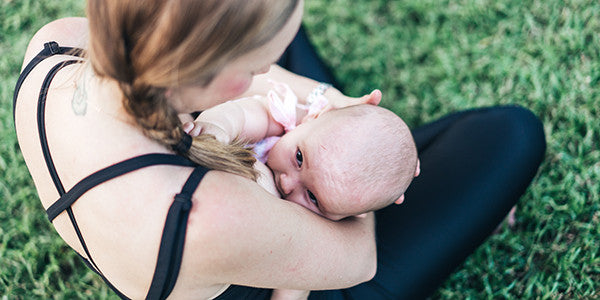It is well known that exercise during the postpartum period has many benefits for the new mother1; It contributes to improved cardiovascular fitness, facilitates weight loss and increases energy levels. Other benefits of a measured postpartum exercise program have shown to be a better sense of psychological well-being, a decreased risk of urinary stress incontinence (you know what I am talking about ladies) and reduced chances of decreased lactation-induced bone loss.
Equally, breastfeeding has also been shown to have many benefits to a new mother (that's even before we consider the positive impacts it has on her baby). In a study of postpartum women, those who breastfed for at least 12 weeks had the least amount weight gain post birth and also when measured a decade later2. The estimated energy expended by lactation is estimated to be approximately 2000 kJ (approx 500 calories) per day3 which is the equivalent of a 63.5 kg (140 lbs) person pound running on a treadmill for 45 minutes4. Every. Single. Day.
If those breastfeeding benefits aren't enough for you, there are a myriad of other positives including the release of feel good hormones (Prolactin produces a peaceful nurturing sensation and Oxytocin promotes a strong sense of love) and a reduced chance of breast and ovarian cancer in later life. Some studies5 have also found that breastfeeding may reduce risks of developing type 2 diabetes, rheumatiod arthritis and cardiovascular disease.
Ok, so breastfeeding and exercising are both excellent activities for the new mother, but.... yes, there is a caveat - any postpartum exercise needs to be introduced gradually. See our post on why the best first exercise for a new mother may be a good lie down. If however, you are ready and have cleared it with your medical practitioner, the following are some tips that can help ease you back into exercise while you are breastfeeding.
Start gently
I know I sound like a broken record, but it is important to take it easy during the immediate postpartum period. The ability of the abdominal muscles to stabilise the pelvis against resistance diminishes during pregnancy and remains decreased at 8 weeks postpartum6. For those needing some extra abdominal support during this period, there are products that provide additional support to the belly mcbelly face, also known as the postpartum stomach. The patent-pending Mammojo Dimity compression top is a good option for those who want good core support, need the functionality of breastfeeding and don't mind looking stylish in the process.
Empty the tanks
Reduce the chances of blocked ducts by breastfeeding or expressing prior to exercise. In the early postpartum weeks, this will probably mean timing your exercise to suit your baby's feeding habits. If however, that child needs a top up during exercise, rest assured Mammojo Lactivewear® will have you covered. Or uncovered, discretely of course, as the case may be.
Nourish yourself
For all that is said about the weight loss benefits of both breastfeeding and exercising, it's important not to use up vastly more energy than you are consuming. Ensure a consistent milk supply by listening to you body and eating when you need to. Hydration is also key as you need additional water for both breastfeeding and exercising. You may also want to consider mineral and vitamin supplements, particularly if you are time poor or struggling to eat a well balanced diet.
Wear a top that incorporates good breast support
Not all sports bras or tops are created equal, or specifically designed for taking care of lactating breasts for that matter. You will want support that is firm enough to keep everything snug but not so firm as to raise the risk of blocked ducts. Equally, as per during pregnancy, anything that incorporates underwire is best avoided.
Watch out for fatigue
Another reason to ease into postpartum exercise is being mindful of fatigue. Lack of sleep, breastfeeding, nutrition and exercise can all contribute to it. Exercise has however been shown to increase feelings of energy provided you don't push yourself too hard. If you are feeling fatigued, consider shortening your exercise period or trying again tomorrow. In my experience, fatigue can have a significant impact on milk supply and that can create a vicious cycle of hungry non-sleeping babies.
Start with appropriate activities
Most of us won't be running a marathon or kicking off our post birth exercise program with extreme weight lifting, but there are some activities that can facilitate a safe return to exercise and put you on the right path to more moderate activities. Some immediate exercises that you may find beneficial are:
-
Gentle yoga and stretching
-
Pelvic floor exercises
-
Taking your baby for a walk
A more moderate intensity exercise program should only be started after your first postpartum checkup and with the approval of your doctor.
Use your baby as part of your weight training
This can be a bit of fun for both mother and baby and can help overcome some of the issues around separation anxiety for little ones. General rules for muscle conditioning exercises apply, in that fatigue, any exercise that is painful, and breath-holding should all be avoided. But before baby Betty becomes your kettle bell make sure that her neck strength is sufficient for such activity. Find a facilitated group class where you can be monitored during your exercises, particularly in the early days, and get ideas for appropriate conditioning exercises. Additional benefits include getting out to talk to another human adult.
There is a lot going on after childbirth. Remember above all else, to look after yourself and your little sleep depriver first and foremost, and gradually ease yourself back into exercise.
Disclaimer: This blog post is not intended to be a substitute for the medical advice of a licensed physician. The reader should consult with their doctor on any matters relating to her health prior to and during breastfeeding or embarking on any new exercise program.
References:
(1) Mottola, Michelle F (2002), Exercise in the Postpartum Period: Practical Applications, Current Sports Medicine Reports.
(2) Rooney BL & Schauberger CW (2002) Excess pregnancy weight gain and long-term obesity: One decade later. Obstet Gynecol 100, 245–252.
(3) Institute of Medicine (2002) Dietary Reference Intakes for Energy, Carbohydrate, Fiber, Fatty Acids, Cholesterol, Protein, Amino Acids (Macronutrients). Washington, DC: National Academies Press.
(4) https://breakingmuscle.com/learn/20-ways-to-burn-500-calories
(5) New Mother's Guide to Breastfeeding, 2nd Edition (Copyright © 2011 American Academy of Pediatrics)
(6) Gilleard WL, Brown JM: Structure and function of the abdominal muscles in primigravid subjects during pregnancy and the immediate postbirth period. Phys Ther 1996, 76:750–762.

